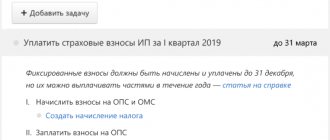Sick leave is issued to an employee due to temporary loss of ability to work and is paid for by the employer or the Social Insurance Fund.
Payments due for the period of incapacity for work are calculated based on average earnings for the last 2 years and the number of days for which a certificate of incapacity for work was issued.
To calculate sick leave, it is necessary to establish the causes of disability and determine whether your region is participating in the pilot project of the Social Insurance Fund (see Decree of the Government of the Russian Federation of April 21, 2011 No. 294).
The listed factors have a direct impact on the accounting entries for the accrual of benefits.
Accounting entries for sick leave when calculating benefits at the expense of the employer
The fiscal operation for calculating the amount of temporary disability benefits is carried out in the same way as in the case of payroll. The debit of the account will depend on which expense account the salary of the employee who issued sick leave is always credited to (in this case, the CREDIT account will always remain 70 “Settlements with personnel for wages”):
| DEBIT account | A comment |
| 20 | If the employee is involved in the main production |
| 23 | When an employee performs labor functions in auxiliary production |
| 25 | When assigning costs to general production expenses |
| 26 | When assigning expenses to general business expenses |
| 29 | Service industries and farms |
| 44 | When assigning payment expenses to selling expenses |
| 91 | Other income and expenses |
Providing funds for spa treatment
The Social Insurance Fund may provide the employer with funds for sanatorium and resort treatment of the employee - in the manner established by the Rules, approved. By order of the Ministry of Labor of Russia dated December 10, 2012 No. 580n. In this case, the voucher can be paid both without the employee’s financial participation, and with partial payment.
The employer most often receives funds from the Social Insurance Fund as part of the social support measure under consideration as targeted financing. And therefore, their receipt will be reflected on account 86 (in correspondence with account 76 - where settlements with employees that are not directly related to the employment contract are reflected):
- DT 76 CT 86.
The posting amount is the actual amount of money subject to compensation from the Social Insurance Fund (it may be less than the nominal price of the voucher if it is partially paid by the employee).
The amount to be reimbursed can be used to reduce the debt on insurance premiums:
- DT 69.12 CT 76.
Since the funding is targeted, the organization is obliged to actually purchase vouchers and register them. If they are brought by courier, then they are registered as a monetary document:
- DT 50.3 CT 76.
The transaction amount will correspond to the full price of the trip.
Payment for the trip to the seller will be reflected by the following posting:
- DT 76 CT 51.
Accounting entries for sick leave when calculating benefits at the expense of the Social Insurance Fund
The accountant should take into account the fact that the reflection in the accounting records of the operation for calculating temporary disability benefits will depend on the reason for being on sick leave (general illness, domestic injury, pregnancy and childbirth, work injury).
Important!
To reflect the accrual of sick leave benefits from the Social Insurance Fund for sick leave in the event of an industrial injury, maternity and disability, separate sub-accounts must be opened to account 69.
| DEBIT | CREDIT | Operation, comment |
| 69 | 70 |
|
| Debit of the subaccount (for calculating social insurance against industrial accidents) to account 69 | 70 | When accruing sick leave benefits in the event of an employee being injured at work (all days are paid from the Social Insurance Fund). |
Setting up the 1C program: Salaries and personnel management ed. 3.1
To enable the functionality we need for working with the “Direct Payments” project in the 1C: Salary and Personnel Management program, edition 3.1, you need to go to the “Settings” section and select the “Organizations” item if you have several enterprises in your database or the “Organization Details” item ”, if she is one enterprise.
Then in the window that opens, go to the “Accounting policy and other settings” tab and click on the “Accounting policy” link.
When the window with the accounting policy settings opens, you need to click on the “FSS Benefits” tab, set the flag “I confirm that the organization is registered in the region with direct payment of benefits through the FSS”, check that the switch below is set to the item “Payment of benefits transferred to FSS from” and in the date column set the transition date.
The program setup is complete.
Legislative regulation
| Art. 183 Labor Code of the Russian Federation | On the right of employees to receive sick leave benefits |
| clause 1 part 2 art. 3 of the Federal Law of December 29, 2006 No. 255-FZ | About sources of payment for sick leave |
| Clause 2 Decree of the Government of the Russian Federation dated April 21, 2011 No. 294 | On the dependence of accounting for the payment of sick leave benefits on the participation of the region where the company is located in the Social Insurance Fund pilot project |
| clause 3 of the Amendments, approved. Decree of the Government of the Russian Federation dated December 19, 2015 No. 1389 | On inclusion in the FSS pilot project. Republic of Mordovia, Bryansk, Kaliningrad, Kaluga, Lipetsk and Ulyanovsk regions |
| Art. 9 Federal Law of July 24, 1998 No. 125-FZ | On compulsory social insurance against accidents and occupational diseases |
| clause 1 art. 217 Tax Code of the Russian Federation | The fact that maternity benefits are not subject to personal income tax |
Accounting
In accounting, calculations for insurance premiums (contributions) for voluntary medical insurance are reflected in account 76-1 “Calculations for property and personal insurance” (Instructions for the chart of accounts).
On the date of payment of the insurance premium (contributions), reflect in the accounting the issuance of the advance:
Debit 76-1 Credit 51 – insurance premiums (contributions) for voluntary medical insurance have been paid.
The payment of the insurance premium does not affect the calculation of VAT, since insurance costs are not subject to this tax (subclause 7, clause 3, article 149 of the Tax Code of the Russian Federation).
Insurance expenses should be recognized in accounting from the date the insurance contract comes into force. If such a date is not provided for in the contract, then it is considered to have entered into force at the time of payment of the insurance premium. This follows from Article 957 of the Civil Code of the Russian Federation.
Costs for voluntary health insurance must be reflected in the cost accounts that reflected the salary of the insured employee.
If the contract is concluded for a period exceeding one month, make the following entry every month when writing off the insurance premium as expenses in accounting:
Debit 20 (08, 23, 25, 26, 29, 44, 91-2...) Credit 76-1 – the cost of the insurance premium for the current month is expensed.
If the term of the insurance contract does not exceed one month, then include the insurance premium as part of the costs in the month when the insurance contract came into force (the insurance premium was paid):
Debit 20 (08, 23, 25, 26, 29, 44, 91-2...) Credit 76-1 – the cost of the insurance premium under the insurance contract was expensed.
If the insurance contract is not valid from the first day of the month, calculate the amount of expenses to be written off in proportion to the number of remaining days of the month.
An example of how calculations under a voluntary health insurance agreement for employees are reflected in accounting
On January 21, 2021, Alpha LLC entered into a voluntary health insurance agreement for employees for a period of 365 days. The contract comes into force from the moment the insurance premium is paid. Payment of the insurance premium is provided in one payment. The insurance premium was paid on January 24, 2021 in the amount of RUB 90,000. The insurance is valid from January 24, 2021 to January 23, 2021.
The accounting policy of the organization for accounting purposes establishes that when determining the insurance premium for voluntary medical insurance of employees, which must be included in the expenses of the current month, the number of calendar days in each month is taken into account.
In accounting, expenses for voluntary health insurance amounted to:
In 2021:
- in January - 1973 rubles. (RUB 90,000: 365 days × 8 days);
- in February - 6904 rubles. (RUB 90,000: 365 days × 28 days);
- in March – 7644 rubles. (RUB 90,000: 365 days × 31 days);
- in April – 7397 rub. (90,000 rubles: 365 days × 30 days);
- in May – 7644 rubles. (RUB 90,000: 365 days × 31 days);
- in June – 7397 rub. (90,000 rubles: 365 days × 30 days);
- in July – 7644 rubles. (RUB 90,000: 365 days × 31 days);
- in August – 7644 rubles. (RUB 90,000: 365 days × 31 days);
- in September – 7397 rub. (90,000 rubles: 365 days × 30 days);
- in October – 7644 rubles. (RUB 90,000: 365 days × 31 days);
- in November – 7397 rub. (90,000 rubles: 365 days × 30 days);
- in December - 7644 rubles. (90,000 rubles: 365 days × 31 days).
In 2021:
- in January – 5671 rub. (90,000 rubles: 365 days × 23 days).
Alpha's accountant made the following entries.
January 24, 2021:
Debit 76-1 Credit 51 – 90,000 rub. – the insurance premium for voluntary medical insurance of employees has been paid.
January 31, 2021:
Debit 20 (08, 23, 25, 26, 29, 44, 91-2...) Credit 76-1 – 1973 rubles. – expenses for voluntary medical insurance of employees for January 2021 are taken into account.
The accountant made similar entries (for the corresponding amounts) at the end of each month until the expiration of the insurance contract.
Common mistakes
Error:
An accountant of a company from the region that is participating in the FSS pilot project displays in the accounting records the accrual of benefits at the expense of the FSS.
A comment:
Employers of firms from regions participating in the FSS pilot project should not display benefits at the expense of the FSS in their accounting records, since the FSS directly transfers the benefit to the employee’s account, without transferring funds to the employer.
Error:
The accountant reflected in the accounting records the payment of sick leave benefits for an industrial injury at the expense of the employer (for the first 3 days).
A comment:
When an employee receives a work-related injury, sick leave benefits for the entire period of sick leave are paid from the Social Insurance Fund.
What is temporary disability
In order to correctly define and indicate temporary disability in documents, it is important to know on what grounds this category is approved
If an employee misses work due to illness or injury at work, he is entitled to compensation and benefits. However, if the illness or injury is not work-related, compensation is not due. However, the employee retains the right to receive benefits or health insurance coverage under a short-term disability program.
Work-related injuries entitle an employee to receive benefits
According to the interpretation of the Labor Code, temporary disability is considered to be a period during which an employee cannot perform his or her official duties.
Temporary disability: concept and classification
Such disabilities are classified into two categories:
- temporary;
- constant.
Based on the specifics of work activity, it can be general or professional. If, for a number of reasons, an employee can no longer perform his or her job titles in accordance with the job description, such disability is recognized as professional. But, at the same time, the employee may be involved in other types of work.
Professional disability implies the inability of an employee to perform his previous tasks
Whether the incident occurs on the job or during off-duty hours, everyone is at risk of becoming disabled, unable to work, and needing assistance through short-term disability insurance. This coverage provides financial support to replace lost income while the employee rests and improves his or her health.
When determining the degree of disability, the commission takes into account a whole range of factors:
- work schedule;
- labor activity;
- the presence of mental or physical stress;
- total load;
- specifics of production;
- working conditions, etc.
Based on the analysis of these criteria, the degree and type of disability is established.
Types of disability
If an employee feels physically unwell, but can continue to perform his job duties, he is not considered disabled. That is, such a status can only be established by a commission created that will conduct an analysis of several evaluative factors. Incapacity for work is declared if a person, for physical reasons, cannot continue to perform his or her official duties.
Documentation and payment procedure
To apply for benefits, the employee must provide a document confirming the reason for deviation from official duties. According to Order No. 624 of June 29, 2011, the Ministry of Health approved a unified standard for drawing up a document confirming temporary disability.
Order No. 624 dated June 29, 2011
For the official release of an employee from his official duties due to illness, only personal documents drawn up in accordance with all the rules are accepted. The accounting department only accepts a document that clearly indicates the period of beginning and end of disability, as well as the reason (a code is written, not a diagnosis).






